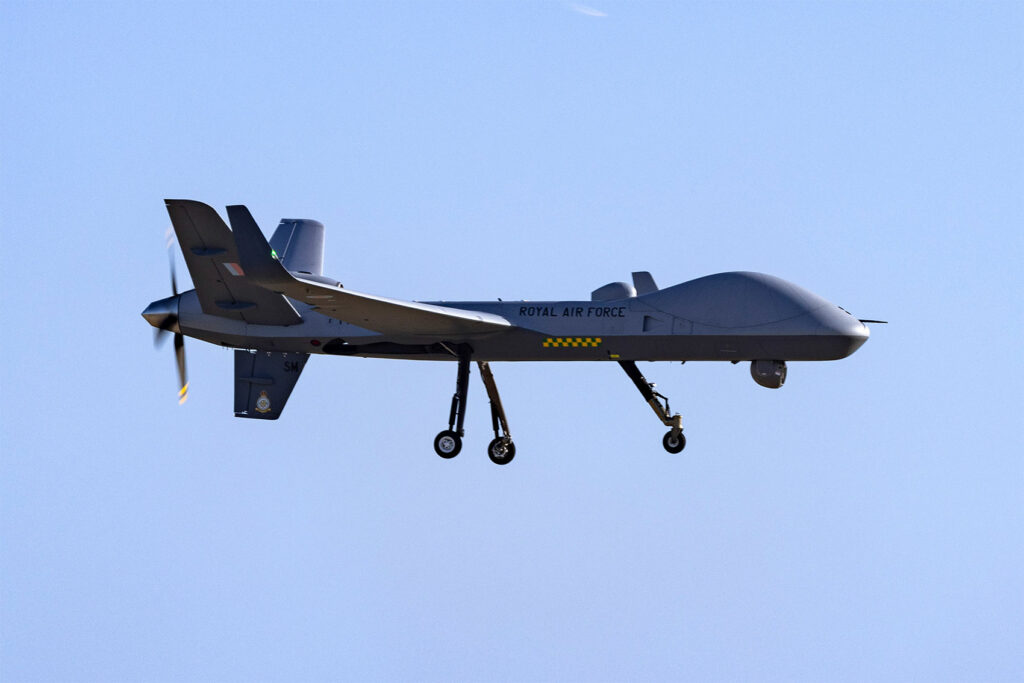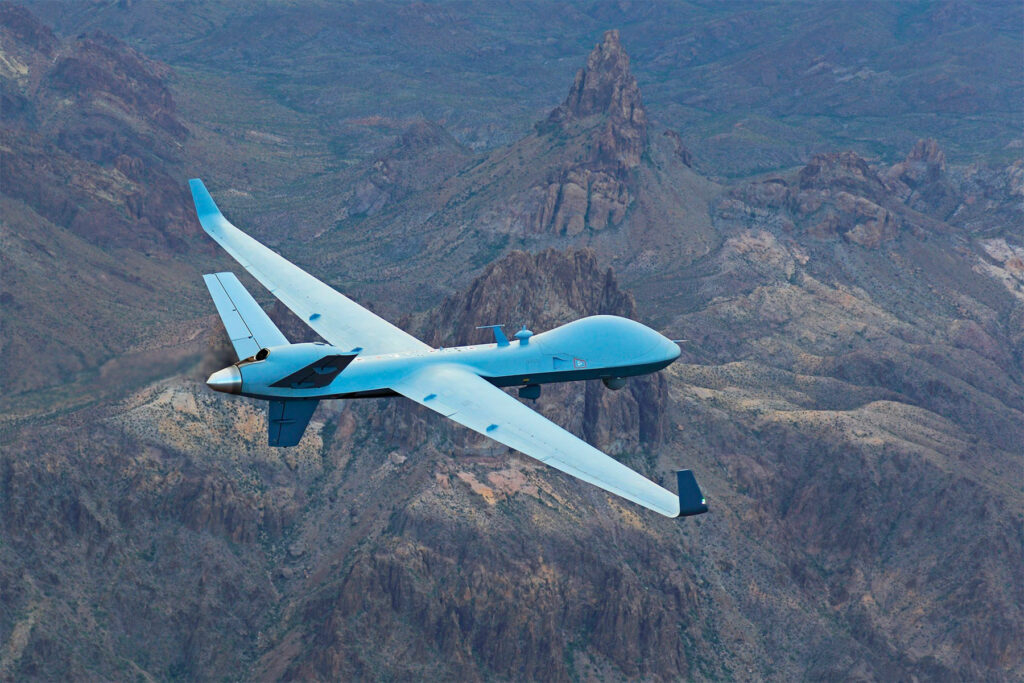The General Atomics MQ-9B is a Medium-Altitude, Long-Endurance (MALE) unmanned aerial vehicle designed for multi-domain operations, including intelligence, surveillance, reconnaissance, and precision strike capabilities.
The General Atomics MQ-9B is an advanced unmanned aerial system (UAS) developed for versatile military applications. It features a fatigue and damage-tolerant airframe with a service life of 40,000 hours. Powered by a Honeywell TPE331-10 turboprop engine, it achieves a maximum speed of approximately 210 knots (389 km/h) and operates at altitudes up to 40,000 feet (12,192 meters). The aircraft boasts an endurance exceeding 30 hours, depending on configuration. Equipped with nine hardpoints, it supports a maximum external payload of 4,750 pounds (2,155 kilograms), accommodating various sensors and munitions. The MQ-9B is designed to meet NATO STANAG 4671 airworthiness standards, enabling safe integration into civilian airspace.
History of the Development of the MQ-9B
In the early 2010s, the increasing demand for unmanned systems capable of operating seamlessly in both military and civilian airspace led to the conceptualization of the MQ-9B. General Atomics initiated the development to create a UAS that complied with international airworthiness standards, particularly NATO STANAG 4671, to enable broader operational deployment.
The development program, known as the Certifiable Predator B, aimed to enhance the existing MQ-9 Reaper platform by incorporating advanced safety features, improved performance parameters, and compliance with civil aviation regulations. The objective was to produce a UAS capable of extended operations over civilian populations and in controlled airspace without compromising safety.
The MQ-9B’s maiden flight occurred in November 2016, marking a pivotal milestone in its development. Following rigorous testing and validation, the platform was unveiled to potential international customers, highlighting its compliance with stringent airworthiness standards and its suitability for a range of mission profiles.
The United Kingdom became a significant early adopter, selecting the MQ-9B for its Protector RG Mk1 program to replace the existing MQ-9A Reapers. This decision underscored the UK’s commitment to integrating advanced unmanned systems into its Royal Air Force operations, with an emphasis on safety and interoperability within European airspace.
The MQ-9B has since evolved into specialized variants, including the SkyGuardian and SeaGuardian, each tailored to specific operational needs. The SkyGuardian focuses on land-based ISR and precision strike missions, while the SeaGuardian is equipped with maritime sensors for naval operations.
As of the mid-2020s, the MQ-9B has been adopted by multiple nations seeking a versatile and certifiable UAS capable of performing a wide array of missions in diverse operational environments.

Design of the MQ-9B
The MQ-9B’s design emphasizes durability, flexibility, and compliance with international airworthiness standards, ensuring its suitability for a broad spectrum of missions.
Airframe and Materials:
Constructed with advanced composite materials, the MQ-9B features a fatigue and damage-tolerant airframe designed for a service life of 40,000 hours. This robust construction enhances durability and reduces maintenance requirements.
Dimensions:
- Wingspan: 79 feet (24 meters)
- Length: 38 feet (11.7 meters)
- Height: 12.5 feet (3.8 meters)
The extended wingspan, featuring winglets, improves aerodynamic efficiency and fuel economy.
Avionics and Systems:
The MQ-9B is equipped with a state-of-the-art avionics suite, including:
- Automatic Takeoff and Landing Capability (ATLC): Enhances operational efficiency and reduces crew workload.
- Detect and Avoid System: Integrates Traffic Collision Avoidance System (TCAS) and Automatic Dependent Surveillance-Broadcast (ADS-B) to ensure safe operation in shared airspace.
- High-Definition EO/IR Sensors: Provide real-time intelligence and targeting information.
Payload and Hardpoints:
The aircraft features nine hardpoints (eight under-wing and one centerline), supporting a maximum external payload of 4,750 pounds (2,155 kilograms). This configuration allows for the integration of various mission-specific payloads, including:
- Weapons: Precision-guided munitions such as the AGM-114 Hellfire missiles and GBU-12 Paveway II bombs.
- Sensors: Maritime surveillance radars and electronic support measures for enhanced situational awareness.
Advantages and Drawbacks:
The MQ-9B’s compliance with international airworthiness standards enables its operation in civilian airspace, expanding its deployment flexibility. Its modular design allows for rapid reconfiguration to meet diverse mission requirements. However, reliance on satellite communications for control can introduce latency, and operations in contested environments may require additional countermeasures to address emerging threats.
Performance of the General Atomics MQ-9B Protector / SkyGuardian / SeaGuardian (Predator B)
The MQ-9B’s performance parameters establish it as a versatile and efficient platform for multi-domain operations, including ISR, precision strike, and maritime surveillance.
Engine and Power:
The MQ-9B is powered by a Honeywell TPE331-10 turboprop engine, delivering 950 shaft horsepower (708 kW). This engine is optimized for long-endurance operations and high fuel efficiency, ensuring extended mission durations and operational cost-effectiveness.
Speed and Altitude:
The maximum speed of the MQ-9B is approximately 210 knots (389 km/h), with a cruising speed of 150-180 knots (278-333 km/h) depending on configuration. It operates at a maximum altitude of 40,000 feet (12,192 meters), allowing for ISR missions above most commercial air traffic and threats.
Range and Endurance:
The MQ-9B offers a maximum range of over 6,000 nautical miles (11,112 km) when equipped with additional fuel tanks, enabling transoceanic missions. Its endurance exceeds 30 hours, depending on payload configuration and operational profile. These capabilities make it suitable for long-duration ISR and patrol missions, particularly in remote or maritime environments.
Payload Capacity:
With a maximum external payload of 4,750 pounds (2,155 kilograms), the MQ-9B can carry a diverse array of weapons and sensors. This includes:
- Air-to-surface munitions: AGM-114 Hellfire missiles, GBU-12/49 laser-guided bombs.
- Maritime surveillance payloads: Radars capable of detecting surface vessels and submersibles.
- ISR sensors: High-definition EO/IR cameras and synthetic aperture radar (SAR).
Operational Systems:
The MQ-9B incorporates advanced systems such as:
- Traffic Collision Avoidance System (TCAS): Ensures safe operation in shared airspace.
- Automatic Dependent Surveillance-Broadcast (ADS-B): Provides real-time positional awareness for operators and air traffic controllers.
- Satellite Communications (SATCOM): Enables beyond-line-of-sight (BLOS) operations, allowing for global control of the aircraft.
Comparison to Competitors:
The MQ-9B competes with platforms like the Bayraktar Akinci and Northrop Grumman RQ-4 Global Hawk. While the Akinci offers stealthier features and a higher payload, the MQ-9B surpasses it in endurance and compliance with NATO airworthiness standards. Compared to the Global Hawk, the MQ-9B provides a more flexible, cost-effective solution for medium-altitude missions, albeit with less operational altitude and endurance.
Operational Flexibility:
The MQ-9B excels in multi-domain operations. It can transition seamlessly between ISR, close air support, and maritime surveillance missions, a capability unmatched by most unmanned aerial systems in its class.
Variants of the General Atomics MQ-9B
The MQ-9B has three primary variants, each tailored for specific operational requirements:
1. MQ-9B SkyGuardian:
This variant focuses on land-based operations, optimized for ISR and precision strike missions. It is equipped with advanced EO/IR sensors and precision-guided munitions, making it ideal for intelligence gathering and counter-terrorism roles.
2. MQ-9B Protector RG Mk1:
Developed for the United Kingdom, the Protector RG Mk1 features enhancements for NATO interoperability and operation in European airspace. It incorporates extended endurance and advanced detect-and-avoid systems to comply with civilian airspace regulations.
3. MQ-9B SeaGuardian:
The SeaGuardian is designed for maritime operations. It includes a maritime radar system for detecting surface and subsurface targets, as well as capabilities for anti-submarine warfare (ASW). Its extended endurance makes it suitable for long-duration maritime patrols.

Military Use and Combat of the General Atomics MQ-9B
The MQ-9B has been widely adopted for military applications due to its versatility, endurance, and ability to carry a diverse payload. Its role spans ISR, precision strike, maritime surveillance, and counter-terrorism operations.
Armament and Payload:
The MQ-9B supports an extensive array of munitions and sensors, including:
- AGM-114 Hellfire Missiles: Effective against armored vehicles and high-value targets.
- GBU-12/49 Paveway II Bombs: Laser-guided munitions for precision strikes.
- High-Definition EO/IR Sensors: Real-time surveillance and targeting.
- Maritime Radars: For SeaGuardian missions, capable of detecting and tracking naval assets.
Combat Operations:
While the MQ-9B is relatively new, its predecessor, the MQ-9A Reaper, has an extensive combat history. The MQ-9B builds on this legacy with enhanced capabilities. For example:
- In counter-insurgency operations, the SkyGuardian variant provides ISR and precision strike support, reducing collateral damage while neutralizing threats.
- In maritime environments, the SeaGuardian monitors vast oceanic regions, tracking illegal fishing activities, piracy, and potential threats to maritime security.
Global Deployment:
The MQ-9B has been adopted by nations such as the United Kingdom (Protector RG Mk1), Japan, and Australia, with several other countries considering procurement. Its compliance with NATO standards facilitates integration into allied operations, ensuring interoperability in joint missions.
Competing Aircraft in Similar Roles:
The MQ-9B faces competition from platforms like the Bayraktar TB2 and Heron TP. While these systems are cost-effective, they lack the range, endurance, and payload capacity of the MQ-9B, making the latter more suitable for extended, high-intensity operations.
Future Potential:
The MQ-9B’s modular design ensures its relevance in future warfare scenarios. Ongoing upgrades include the integration of new munitions, electronic warfare capabilities, and improved sensor systems.
The General Atomics MQ-9B represents the next generation of unmanned aerial systems, combining endurance, versatility, and compliance with stringent airworthiness standards. Its ability to perform multi-domain operations, including ISR, precision strike, and maritime surveillance, ensures its strategic value for modern armed forces. With ongoing upgrades and adoption by multiple nations, the MQ-9B remains a cornerstone of unmanned aerial operations worldwide.
Back to the Drones, UAVs, UCAVs page